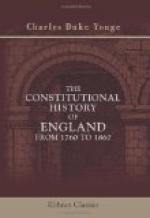[Footnote 237: “Middle Ages,” ii., 31 seq. See also Stubbs, “Constitutional History,” i., 82-92 et seq.]
[Footnote 238: See Hallam’s “Constitutional History,” ii., 155.]
[Footnote 239: This was a matter of no small importance. The number of boroughs included in the bill was 183, having a population of about two millions. Their annual income was stated by Lord John Russell to be as nearly as possible L2000 a year for each, being L367,000; but their annual expenditure exceeded that amount by L10,000, being L377,000; “besides which there was a debt of L2,000,000 owing by these bodies.”]
[Footnote 240: See Hallam, “Middle Ages,” ii., 205-207.]
[Footnote 241: “Life of Pitt,” ii., 131. Lord Stanhope imagines that the plan was relinquished in consequence of discouraging comments by the Archbishop (Dr. Moore).]
[Footnote 242: These objections were founded on the following calculations, or something similar to them. The tithe was the tenth of the produce. In letting estates it was estimated that a farm ought to produce three rents; in other words, that a farm let at L1 an acre ought to produce yearly L3 an acre. One-tenth of three pounds, or 6s., therefore, was what the clergyman was entitled to claim. Out of this, however, he had to defray the cost of collection, which might, perhaps, be one shilling, leaving him five shillings. But the average of compositions over the whole kingdom was under 2s. 9d., or eleven-twentieths of what he was entitled to; and if augmented by ten per cent., it would not exceed three shillings.]
[Footnote 243: The fund so created was expected to amount to L130,000 a year.]
[Footnote 244: As instances of the want of church-room in such towns, Lord John cited the dioceses of London, Chester, York, Lichfield, and Coventry, containing a population of 2,590,000 persons, with church accommodation for only 276,000, or one-ninth of the population; the Commissioners, from whose report he was quoting, reckoning that church-room ought to be provided for one-third.]
CHAPTER XI.
Death of William IV., and Accession of Queen Victoria.—Rise of the Chartists.—Resignation of Lord Melbourne in 1839, and his Resumption of Office.—Marriage of the Queen, and Consequent Arrangements.—The Precedence of the Prince, etc.—Post-office Reform.—War in Afghanistan.—Discontent in Jamaica.—Insurrection in Canada.—New Constitution for Canada and other Colonies.—Case of Stockdale and Hansard.




